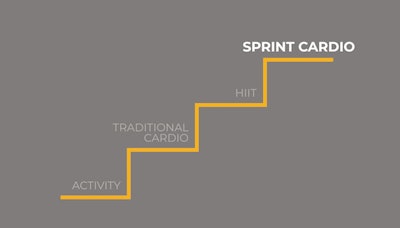
This sponsored content was provided by Matrix. What is sponsored content?
It might surprise you to hear that high-intensity interval training could help fight cancer, but recent findings suggest just that. While HIIT programs like Sprint 8 have been proven to help burn fat and build muscle through the release of growth hormone, they also achieve an adrenal response that strengthens the immune system in a way that has been shown to target tumors in mice.1
Scientists have known that tumor-killing immune cells can attack tumors and reduce their size, in fact, studies in old and young humans have found that exercise increases the activity of these tumor-killing immune cells.2,3 The level of intensity reached appears to be critical, because regular low-intensity exercise does not reliably improve how tumor-killing immune cells function,4 in contrast to those who reach higher exercise intensities.5 A remaining question has been: how do tumor-killing immune cells find their way to the correct site in the body? Recent research suggests that specific types of exercise may have the answer.
 The Sprint 8 program from Matrix Fitness takes things one step beyond traditional high intensity interval training.
The Sprint 8 program from Matrix Fitness takes things one step beyond traditional high intensity interval training.
In 2016, researchers demonstrated in a major, first-of-its-kind study that exercise intense enough to release an adrenaline surge into the body of mice will also cause the body to direct tumor-killing immune cells to the site of tumors.1
During the study, some mice were blocked from their running wheel and could not do sprint cardio. These mice showed no reduced tumor size. However, the mice that did sprint cardio reduced tumor size by over 50 percent, even in old mice. Researchers credit the adrenaline surge and immune-strengthening effect of sprint cardio for directing the cancer-killing immune cells to the tumors.1
Study spokesperson, Dr. Pernille Hojman, reported:
"That was actually a big surprise to us. As someone working in the field of exercise and oncology, one of the main questions that cancer patients always ask is, 'How should I exercise? Can we do anything?'"
While it has previously been difficult to advise people about the intensity at which they should exercise, our data suggest that it might be beneficial to exercise at a somewhat high intensity in order to provoke a good adrenaline surge and hence recruitment of NK cells.6
In another experiment, Dr. Hojman’s research team injected mice with either adrenaline or a control solution (salt water). The surge of adrenaline reduced the growth of tumors by 61 percent in the mice that didn’t do sprint cardio. However, this was not as impressive as the mice that reduced their tumors by 74 percent with natural sprint cardio exercise.
So can HIIT programs like Sprint 8 improve our tumor-killing immune cells function? Further research is warranted, but these recent studies suggest exercise may be among the best ways to keep yourself healthy. In the interim, I’m doing Sprint 8 three times a week.
Visit Sprint8.com to learn more about the protocol and the science behind it.
Phil Campbell is a certified personal trainer with the American College of Sports Medicine and the creator of the Sprint 8 training program.
References:
1. Pedersen L, Idorn M, Olofsson GH, Lauenborg B, Nookaew I, Hansen RH, Johannesen HH, Becker JC, Pedersen KS, Dethlefsen C, Nielsen J, Gehl J, Pedersen BL, Straten PT, Hojman P. Voluntary Running Suppresses Tumor Growth through Epinephrine- and IL-6-Dependent Natural Killer Cell Mobilization and Redistribution. Cell Metabolism 23(3) 2016. 554-562. https://doi.org/10.1016/j.cmet.2016.01.011.
2. Fiatorone MA, Morley JE, Bloom ET, Benton D, Makinodan T, Solomon GF. Endogenous Opioids and the Exercise-Induced Augmentation of Natural Killer Cell Activity. J Lab Clin Med. 1988. 112. 522-552.
3. Crist DM, Mackinnon LT, Thompson RF, Atterbom HA, Egan PA. Physical Exercise Increases Natural Cellular-Mediated Tumor Cytotoxicity in Elderly Women. Gerontology 35. 1989. 66-71
4. Nieman DD, Henson DA, Gusewitch G, Warren BJ, Dotson RC, Butterworth DE, Nehlsen-Cannarella Sl. Physical Activity and Immune Function in Elderly Women. Med Sci Sports Exercise 25. 1993. 823-831.
5. Shinkai S, Konishi M, Shephard RJ. Aging, Exercise, Training and the Immune System. Exercise Immun Rev 3. 1996. 68-95.
6. Cell Press. (2016, February 16). Running helps mice slow cancer growth. ScienceDaily. Retrieved Feb 18, 2016 from www.sciencedaily.com/releases/2016/02/160216142825.html




































